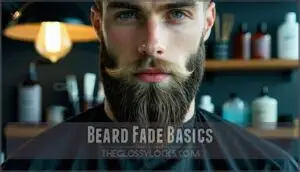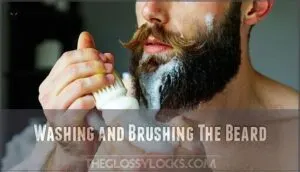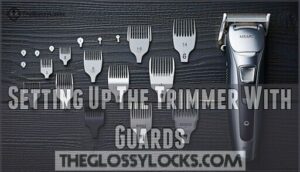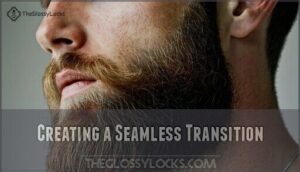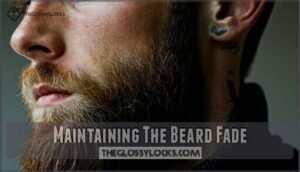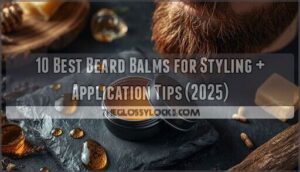This site is supported by our readers. We may earn a commission, at no cost to you, if you purchase through links.
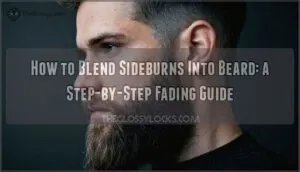
Using a trimmer, begin with the longest guard to trim your beard evenly, then switch to a slightly shorter guard for the sideburns. Focus on fading by decreasing guard size as you move from the bottom of your ear toward the jawline.
Work in layers, checking symmetry as you go. Blend carefully to avoid harsh lines, and finish with scissors for touch-ups. It takes patience, but a polished fade is worth it.
Ready for pro tips?
Table Of Contents
- Key Takeaways
- Beard Fade Basics
- Blending Sideburns Into Beard
- Preparing for Beard Fade
- Step by Step Fading Process
- Maintaining The Beard Fade
- Frequently Asked Questions (FAQs)
- How to blend beard and sideburn?
- Do sideburns turn into a beard?
- How do I grow my beard on my sideburns?
- How do I blend my beard into my sideburns?
- Should I trim sideburns when growing a beard?
- How long should I let my beard grow before fading?
- Are there any special techniques for fading a long beard?
- How often should I trim my beard to maintain a fade?
- What can I do to keep my fade from looking patchy?
- How do I fade a curly beard?
- Conclusion
Key Takeaways
- Start with the longest guard on your trimmer, then gradually decrease sizes to create a smooth blend between your sideburns and beard.
- Always trim on dry, clean, and brushed facial hair to avoid patchiness and ensure an even fade.
- Work in small, overlapping sections while following your hair’s natural growth direction for a seamless transition.
- Maintain the fade by trimming every 1-2 weeks and using beard oil for hydration and a polished look.
Beard Fade Basics
A beard fade creates a smooth progression from your sideburns to your beard by blending hair of different lengths.
A beard fade seamlessly blends sideburns and beard for a sharp, polished look that enhances your facial structure effortlessly.
It’s a simple technique that adds sharpness and balance to your overall look.
Definition of Beard Fade
Imagine this—your beard and sideburns flowing together in perfect harmony. That’s the magic of a beard fade. It’s all about creating a smooth gradient effect by blending your sideburns into your beard without harsh lines. The goal? A polished, stylish appearance.
- Blending Zones facilitate a natural shift.
- Defining Lengths keeps proportions balanced.
- Fade Styles fit any beard length and face shape.
Benefits of Beard Fading
A great beard fade adds much more to your look than just style—it boosts confidence and defines your appearance.
Blending sideburns into your beard elevates your facial structure while maintaining a natural balance.
Blending sideburns into your beard enhances your facial features, creating a smooth, balanced, and confident look effortlessly.
Here’s why fading sideburns beard is worth it:
- Polished Appearance: Achieve a sleek, professional look with a seamless beard blend.
- Enhanced Symmetry: A well-faded beard sideburns style evens out your face structure.
- Versatile Styles: Experiment with fade heights to define your signature beard blending.
Enjoy a sharper, more defined jawline and face-slimming effect effortlessly!
It also requires precision beard clippers for best results.
Tools Required for Beard Fading
To get your beard fade just right, you’ll need a mix of precision and good tools. A beard trimmer with adjustable length combs is your go-to for blending smoothly.
Pair it with quality trimmers featuring varied length guards, ensuring flexibility while avoiding mistakes. For those seeking replacements, you can often find specialized trimmer attachments online.
A trusty beard comb helps straighten and prep your beard before trimming. Don’t skip a well-lit mirror—it’s a lifesaver for catching uneven spots. Add a touch of grooming flair with shaving gel for sharper lines.
Here’s a quick equipment guide:
| Tool | Purpose | Recommendation | Benefit |
|---|---|---|---|
| Trimmer Guards | Gradual fading | Adjustable combs | Precision length control |
| Beard Comb | Preps beard hairs | Wooden or plastic | Smooth, tangle-free beard |
| Length Guards | Sets fade increments | Organized guards | Uniform, controlled blending |
| Shaving Gel | Sharp edges | Transparent gels | Cleaner, polished look |
Blending Sideburns Into Beard
Blending sideburns into your beard requires precision to create a seamless merge.
Focus on gradual increments to connect your sideburns naturally without visible lines. Start by establishing a baseline that aligns with your natural hairline. Trim downward for uniformity, maintaining fullness throughout.
Sideburns beard grooming is all about balance—ensure both sides match for symmetry.
- Tips for Sideburn Fading:
- Start with a higher guard, working downward.
- Follow natural growth direction for smoother results.
- Keep sideburns shorter than the beard for proper blending.
- Prioritize small, careful adjustments for control.
Preparing for Beard Fade
Before you start blending, make sure your beard is clean, brushed, and free of tangles. Setting up your trimmer with the right guards guarantees a smooth, even fade.
Washing and Brushing The Beard
Consistency matters when starting your fade. Clean your beard with a quality beard shampoo; wash it 2-3 times a week to avoid dryness.
After beard cleansing, detangle gently using a wide-tooth comb. Follow up with a boar-bristle brush to spread natural oils evenly, promoting beard health.
This step enhances softness and sets the stage for a smoother trim. Healthy prep makes certain your beard’s ready for a smooth blending experience.
Trimming The Beard to Desired Length
When trimming your beard to the desired length, start by choosing your Beard Length Goals thoughtfully.
Set your trimmer to its longest guard size and trim against the grain for a Uniform Length Achieved. This step helps you shape your beard style while maintaining symmetry.
Pay attention to how your sideburns blend with your beard for a Seamless Beard Merge. For achieving the perfect length, consider using different trimmer attachments.
Thicker beard hair may need multiple passes, so stay patient. Use a reliable trimmer to refine your Desired Beard Look, ensuring the connection between your face and beard feels natural during this sideburns beard tutorial process.
Setting Up The Trimmer With Guards
Setting up your trimmer properly is key for a smooth fade. Start by organizing your guards in descending order to create a seamless blend. Verify the blades are clean, as dirty clippers can tug or miscut your beard.
Select guard sizes based on your baseline length and density. One should also consider that adjustable guide combs offer a range of lengths for various styles.
Here’s a quick checklist:
- Organize guards for easier switches during beard trimming.
- Test adjustable levers, verifying the right guard settings for sideburns.
- Pick quality tools, like reliable trimmer brands.
- Clean clippers thoroughly before use.
- Estimate length needed for your ideal sideburn-beard blend.
Proper setup confirms precision trimming throughout.
Performing a Dry Run With Guards
Before starting, test your trimmer’s guard settings to preview your beard fade.
Hold each guard against your facial hair to check length and confirm a clean sideburn-to-beard connection.
This step lets you estimate guard sizes and avoid over-trimming.
Use the table below for guidance:
| Guard Type | Use |
|---|---|
| Larger Guard | Test baseline length |
| Medium Guard | Plan gradual fade |
| Smaller Guard | Shape sideburn progressions |
| Adjustable Guard | Refine tricky areas |
| No Guard | Shape neckline precisely |
This prevents common mistakes while shaping your fade.
It is essential to follow these steps carefully to achieve a well-defined and clean look, ensuring a precise connection between your sideburns and beard, and to refine tricky areas.
Step by Step Fading Process
Here’s where you’ll master the step-by-step process to seamlessly blend your sideburns into your beard.
By following a clear method—starting with the longest guard and working your way down—you’ll achieve a smooth and polished fade every time.
Starting With The Longest Guard
When you’re ready to blend sideburns with your beard, begin with the longest guard on your trimmer. This “safety net” keeps your initial trim length in check, preventing over-trimming.
Here’s how to start:
- Guard Length Choice: Select one slightly shorter than your beard length.
- Longest Guard Purpose: Preserve the sideburn-beard connection.
- Estimating Hair Removal: Let it guide your next steps.
- Dry Run Benefits: Visualize the fade.
- Start Gradual: Remember, less is more.
Using the correct trimmer guard sizes is essential for an even fade.
Gradually Decreasing Guard Size
Wondering how to nail a seamless beard shift? Start reducing the guard size in increments, like moving from #4 to #3.
Work upward, blending techniques like overlapping sections help create a smooth gradient. Use consistent pressure with your clipper to avoid lines or uneven spots.
Think of it as painting—you’re shading toward perfection. Go section by section, ensuring each layer blends naturally into the next, to achieve a polished beard fade.
These trimming techniques guarantee a flawless blend, keeping the blend sideburns beard flawless.
Fading From The Bottom of The Ear
To blend sideburns into your beard using an ear-level fading technique, focus on creating a smooth shift in length near the bottom of your ear.
Use precise guard selection and small steps to avoid blending challenges.
Follow these steps:
- Place your trimmer at mouth level, near the ear’s base.
- Trim upward toward your sideburn’s top using gradual guard decreases.
- Keep a steady, horizontal line from ear to mustache.
- Work in tiny, overlapping strokes for flawless hair blending.
- For a seamless look, remember to focus on gradual guard shifts.
- Respect your natural hairline for balanced beard shaping sideburns, ensuring a smooth and natural appearance with precise guard selection and attention to your beard’s overall style.
Creating a Seamless Transition
To create a seamless beard and sideburn connection, start near your natural hairline with trimmer guards, working in gradual increments.
Use larger guards for the baseline removal, creating even hair blending. Mid-sized guards refine the shift, while smaller guards and no guards detail the edges.
Maintain fullness by trimming sideburns beard in smooth strokes. Patience guarantees a flawless seamless beard blend—work carefully to connect sideburns beard without harsh lines, ensuring a seamless connection.
Maintaining The Beard Fade
Keeping your beard fade sharp takes regular upkeep, so make trimming a part of your routine.
Stick to consistent maintenance and proper tools to guarantee a clean, polished look every time.
Regular Trimming and Maintenance
To keep your fade fresh, plan for consistent trimming every 7–10 days.
This helps avoid losing the sharp definition of your trimming sideburns beard.
Clean your trimmer often to guarantee smooth, precise cuts for seamless beard transitions.
Add beard oil or balm after each trim—it hydrates hair and enhances shape retention.
Regular cleaning helps with trimmer blade maintenance.
Check for unevenness during regular touch-ups, focusing on beard and sideburn maintenance.
With proper fade upkeep and styling techniques, your beard will stay polished and professional without constant trips to a barber, ensuring a professional look.
Tips for a Polished and Well-Groomed Look
Achieving a polished look goes beyond mastering a seamless beard and sideburn blend. It’s about creating harmony in your overall style.
Follow these simple tips:
- Match your hairstyle to your beard and face shape for balance and symmetry.
- Use daily product application, like beard oil, to hydrate your fade and prevent dryness or itchiness.
- Regularly check for beard symmetry using multiple mirrors—it’s the key to maintaining that natural blend.
- Snap a photo of your barber’s work to reference this beard sideburns guide during home trims.
By combining styling techniques and professional grooming, you’ll perfect your look effortlessly, achieving a natural blend and seamless beard with balance and symmetry.
Common Mistakes to Avoid in Beard Fading
Avoid these common beard fading pitfalls to achieve a smooth sideburn shift.
Uneven fades happen when you rush or use the wrong tools—always go for clippers with guards.
Wet trimming leads to patchy growth, so stick to dry hair.
Ignoring upkeep causes inconsistent results, so stay on a routine.
| Mistake | Problem | Solution |
|---|---|---|
| Wet Trimming | Leads to patchy growth | Trim dry hair |
| Wrong Tools | Causes uneven fades | Use clippers with guards |
| Ignoring Upkeep | Results in inconsistent trimming | Maintain regular trims |
Follow the hair’s natural direction, avoid harsh lines, and use patience for a natural blend.
This will help you achieve a natural blend and prevent common mistakes.
Frequently Asked Questions (FAQs)
How to blend beard and sideburn?
Start by trimming your sideburns with a longer guard, then gradually switch to shorter guards as you move downward.
Overlap sections slightly, follow the hair’s natural growth, and blend smoothly for a seamless change.
Do sideburns turn into a beard?
Yes, sideburns can turn into a beard if you let them grow and connect naturally.
By blending lengths with a trimmer and following your hair’s growth pattern, a seamless evolution creates that polished, unified look.
How do I grow my beard on my sideburns?
To grow your beard on your sideburns, let the hair grow naturally without shaving or trimming.
Keep the area clean, moisturized, and apply beard oil.
Patience is key since growth rates vary for everyone.
How do I blend my beard into my sideburns?
It’s funny how a slight tweak transforms your look.
To blend your beard into sideburns, use a trimmer with descending guard sizes, follow your hair growth, and overlap sections gradually for a seamless merge.
Should I trim sideburns when growing a beard?
Trimming sideburns while growing a beard helps maintain shape and avoid a scruffy look.
Keep them tapered to blend smoothly into the beard, using a trimmer with adjustable guards.
Balance is key for a polished finish.
How long should I let my beard grow before fading?
Let your beard grow for at least 2-4 weeks before fading.
This gives enough length to create a smooth progression, ensuring the fade looks balanced and natural.
Patience now saves you from patchy results later.
Are there any special techniques for fading a long beard?
To fade a long beard, start with longer guards, gradually step down sizes, and blend slowly.
Use scissors for detail work, follow your hair’s natural pattern, and comb frequently for an even, seamless shift, to ensure a seamless transition between different lengths.
How often should I trim my beard to maintain a fade?
Maintaining a fade is like keeping a fire steady—you’ll need regular attention.
Trim your beard every one to two weeks to keep lines crisp, hair blended, and your fade looking sharp and polished.
What can I do to keep my fade from looking patchy?
Use quality trimmers, start with longer guards, and blend gradually to avoid harsh lines.
Follow your hair’s natural pattern, moisturize with beard oil, and check for uneven spots regularly to keep your fade looking sharp.
How do I fade a curly beard?
Start by detangling your curly beard with a comb.
Trim gradually with a higher guard, working downward to blend.
Follow the natural curl pattern, use shorter settings for details, and finish with beard oil for smoothness.
Conclusion
Mastering how to blend sideburns into your beard combines precision with patience.
A clean, brushed beard sets the stage, while the right trimmer guards create a smooth fade.
Work methodically, starting with longer guards and gradually using shorter ones for seamless shifts.
Regular maintenance keeps the fade sharp, ensuring your beard stays polished.
Take your time to perfect the technique—it’s worth it.
With practice, you’ll achieve a professional, well-groomed look effortlessly.
Your beard is your canvas—own it!
- https://www.healthline.com/health/beard-dandruff
- https://www.nytimes.com/wirecutter/reviews/best-beard-trimmer/
- https://www.gillette.co.uk/blog/how-to-shave/how-to-stop-an-itchy-beard/
- https://www.google.com/search?sca_esv=07057cd0c5299605&gl=US&hl=en&pws=0&cs=0&sxsrf=AHTn8zps6s7AX0uhhY359pJJSoVI1TNEpA:1737721432581&q=Sideburn+fade+beard+black+man&sa=X&ved=2ahUKEwiDw9HlrI6LAxX1yAIHHXV-EJIQ1QJ6BAgDEAE

